aga
Forum Drunkard
    
Posts: 7030
Registered: 25-3-2014
Member Is Offline
|
|
Making Calcium Chloride,and anhydrous
Assumption : CaO + 2 HCl => CaCl2 + H2O
Further assumption : Technical Grade CaO is relatively Pure
Further (quite probably false) assumption: This 35% HCl is pure
So what's the Brown fluffy stuff piled up at the bottom of the beaker ?
It filters out easily enough, giving an almost clear liquid, where i expect the CaCl2 is.
I'll boil the liquid to dryness, hoping for pure-ish CaCl2 crystals.
As it is so hygroscopic, is it possible to do a recrystallisation on it ?
|
|
|
Zyklon-A
International Hazard
    
Posts: 1547
Registered: 26-11-2013
Member Is Offline
Mood: Fluorine radical
|
|
Brown fluffy stuff is an impurity, as you know.
You might be able to recrystallize it, but probably not just by cooling a hot saturated solution. Leaving the anhydrous out creates so many hydrates
that it dissolves in them. A vacuum would work, or a desiccator. Try boiling off the water until you see crystals and retrieve them quickly should
work to get one of the hydrates. Repeat several times and it should be decently pure I assume.
[Edited on 18-9-2014 by Zyklon-A]
|
|
|
aga
Forum Drunkard
    
Posts: 7030
Registered: 25-3-2014
Member Is Offline
|
|
Vacuum !
Brilliant.
Cheers Zyklon.
|
|
|
Texium
Administrator
       
Posts: 4508
Registered: 11-1-2014
Location: Salt Lake City
Member Is Offline
Mood: PhD candidate!
|
|
A long time ago as one of the very first chemistry experiments that I did, I made some very crude calcium chloride from native limestone and HCl.
Boiling it down and continuing to heat it for a while may not have rendered it anhydrous, but definitely dehydrated it somewhat, because it dissolved
exothermically in water. (It also happened to be one of our rare ice days, and I was able to melt a hole through a 2cm thick chunk of ice with several
granules of it, and used the rest to de-ice the sidewalk).
|
|
|
aga
Forum Drunkard
    
Posts: 7030
Registered: 25-3-2014
Member Is Offline
|
|
So a test will be how hot the crystals get when water is added.
Thanks zts
|
|
|
aga
Forum Drunkard
    
Posts: 7030
Registered: 25-3-2014
Member Is Offline
|
|
Update :
The CaO and HCl were reacted (gets very hot), then hot filtered twice to remove the brown fluffy stuff, leaving ~300ml of a faintly yellow-tinged
clear liquid.
This was boiled down in a beaker, using the PC-fan-on-top trick, which worked very well.
At ~100ml, the liquid started to become more viscous, and spattered droplets up the sides of the beaker.
The beaker was left to cool for a while, but the goopy mass did not solidify - it become more mobile, presumably absorbing water from the air.
Finding that the melting point of CaCl2 is 772 C, i dumped the contents of the beaker directly onto the hotplate (in batches).
That worked.
It felt more like being a burger chef, scraping the stuff up and flipping it over, however it yielded 94g of anhydrous Calcium Chloride.
A few grains on a glass slide deliquesced within 5 minutes.
Now to see if it takes the remaining water out of toluene, which was the whole point of making it ...
[Edited on 19-9-2014 by aga]
|
|
|
macckone
International Hazard
    
Posts: 2159
Registered: 1-3-2013
Location: Over a mile high
Member Is Offline
Mood: Electrical
|
|
How dry do you need the toluene?
CaCl2 will be better for bulk water removal.
CaO will be better for removing traces.
A molecular sieve will be best for removing traces.
|
|
|
Zyklon-A
International Hazard
    
Posts: 1547
Registered: 26-11-2013
Member Is Offline
Mood: Fluorine radical
|
|
Cool! How were your yields, based on the calcium oxide you started?
|
|
|
aga
Forum Drunkard
    
Posts: 7030
Registered: 25-3-2014
Member Is Offline
|
|
DOH !
I already had CaO, and molecular sieves ...
Never had much success with sieves.
They're 4A and seem to just end up soaking up whatever it i want to dry rather than the water.
Sadly no idea what they yield is, as i didn't measure the CaO.
Being the first time i've ever tried this reaction i was just 'dry running' it to see what happened, and didn't expect to get any reasonable results.
|
|
|
Praxichys
International Hazard
    
Posts: 1063
Registered: 31-7-2013
Location: Detroit, Michigan, USA
Member Is Offline
Mood: Coprecipitated
|
|
Anhydrous calcium chloride prills are sold here as driveway ice melting granules, or in desiccators for damp areas like basements. It might be cheaper
to just buy it rather than go through the trouble of making it. Good job, though.
CaO can be used directly as a desiccant for toluene without reaction, but in some cases the Ca(OH)2 that forms can be difficult to filter from the
solvent. It works in theory, but is probably difficult in practice without a vacuum filtration system.
Both CaO and CaCl2 can be regenerated by heating. CaCl2 will dehydrate at a lower temperature. 300C is great for CaCl2, but Ca(OH)2 does not
decompose back to CaO until it is substantially hotter than that.
The other problem with re-using CaO is that both CaO and Ca(OH)2 will eventually soak up CO2 from the atmosphere and form CaCO3. This can be heated to
release both water and CO2 but at even higher temperatures, approaching 900C for a reasonable rate of reaction.
Oh, and try 3a sieves for a higher water selectivity. 3a works better on smaller molecules like methanol, ethanol, and acetone. Use sieves only after
you have removed most of the water chemically though, ideally less than 0.5%. You should be able to get to the tens of ppm water content with sieves.
http://ccc.chem.pitt.edu/wipf/Web/Solvent_Drying.pdf
My $0.02.
|
|
|
Little_Ghost_again
National Hazard
   
Posts: 985
Registered: 16-9-2014
Member Is Offline
Mood: Baffled
|
|
Quote: Originally posted by aga  | DOH !
Sadly no idea what they yield is, as i didn't measure the CaO.
Being the first time i've ever tried this reaction i was just 'dry running' it to see what happened, and didn't expect to get any reasonable results.
|
Yep that's my trouble as well! I think until we stop doing this, then we are doomed to be noobs forever!
I get an idea and think I will just see what happens if............ No records or anything.
I have now stopped this approach, my new rules are.
1) Notepad and pen in lab at all times
2) Take as many measurements as I can
3) write ALL measurements down the MOMENT they are taken, instead of thinking 'I will write that down in a min'
4) note time when I take measurements
5)Write what I think and what I actually do!
6) Learn to write faster lol
7) Note every thing
8) Be prepared, for example I now have a excel sheet I made for distillations.
it just has the time and temperature/temperatures , notes etc in columns. But this makes it quick and easy to fill in while doing the distillation .
I am trying my best to stick with these from now on, for ease I may use my mobile phone voice record thing if busy, but then write everything down as
soon as I get the chance.
I am glad I am not the only one that does/did dry runs
|
|
|
MrHomeScientist
International Hazard
    
Posts: 1806
Registered: 24-10-2010
Location: Flerovium
Member Is Offline
Mood: No Mood
|
|
The brown fluffy junk is undoubtedly iron 'goop' (hydroxide, oxide, etc.) - commercial HCl is very frequently contaminated with iron (hence the
yellowish color).
The sources Praxichys mentions for anhydrous CaCl2 are also good ones, definitely easier than making it yourself! Unless
of course you want to just for the fun of it (which I do often). One brand that is everywhere around where I live is Damp Rid, sold as a dehumidifier
for closets, basements, RVs, etc. So I have access to tons of anhydrous calcium chloride! 
|
|
|
macckone
International Hazard
    
Posts: 2159
Registered: 1-3-2013
Location: Over a mile high
Member Is Offline
Mood: Electrical
|
|
Cool reaction with calcium chloride solution.
Add sodium carbonate or Epsom salt solution.
Instant precipitate.
|
|
|
aga
Forum Drunkard
    
Posts: 7030
Registered: 25-3-2014
Member Is Offline
|
|
Yay ! It worked.
Thanks for the comments and suggestions peeps.
I dried the toluene with the CaO as macckone suggested. It fizzed briefly, then it all got filtered.
Then tried it with the Calcium Chloride - nothing happened at all.
Filtered again, and the Toluene that used to go cloudy when shaken now stays perfectly clear.
This it the poor old toluene ripped from a mix with methanol, acetone and methyl acetate using water, and lots of shaking.
So my 4A sieves are just too big. Will get some 3a ones.
It is all just for fun. I have no immediate use for anything in my possession, which now includes 93g anhydrous CaCl2 and about 200ml dry
Toluene !
For the fun of it, i thought i'd make some Ca(NO3)2 as well.
This time with some notes taken, somewhere, on something ...
|
|
|
WGTR
National Hazard
   
Posts: 971
Registered: 29-9-2013
Location: Online
Member Is Offline
Mood: Outline
|
|
Here is a reference that I pulled out of the cobwebs of my head:
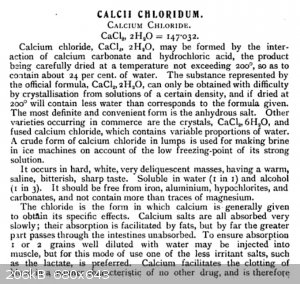 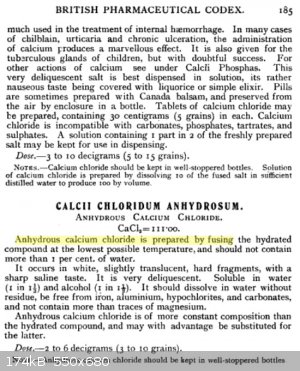
Something like magnesium chloride hydrolyzes easily, releasing HCl as it dries if no particular care is taken. Calcium chloride is much less prone
to this, but it's a good idea to dry it in stages as mentioned above.
Also note that drying at 200°C still leaves about 24% water.
When I prepared small amounts of anhydrous CaCl2, I gradually heated the hydrated salt in a ceramic crucible until it melted (red heat).
After all bubbling ceased, the molten salt was poured out onto a cold surface to solidify.
You can take small amounts of the dried salt and dissolve it in water, to make sure that everything dissolves. If the solution is cloudy, there was
some decomposition of the salt.
|
|
|
blogfast25
International Hazard
    
Posts: 10562
Registered: 3-2-2008
Location: Neverland
Member Is Offline
Mood: No Mood
|
|
Quote: Originally posted by MrHomeScientist  | The brown fluffy junk is undoubtedly iron 'goop' (hydroxide, oxide, etc.) - commercial HCl is very frequently contaminated with iron (hence the
yellowish color).
|
Probably but the grade of CaO he started from was technical CaO: in plain English, burnt, clean limestone. That's gonna contain some gunk because it's
not pure CaCO<sub>3</sub>.
'Synthetic' CaO might not give any goop at all.
|
|
|
aga
Forum Drunkard
    
Posts: 7030
Registered: 25-3-2014
Member Is Offline
|
|
Quote: Originally posted by WGTR  | | When I prepared small amounts of anhydrous CaCl2, I gradually heated the hydrated salt in a ceramic crucible until it melted (red heat).
After all bubbling ceased, the molten salt was poured out onto a cold surface to solidify. |
Ah. Mine's probably just a bit less wet then, rather than anhydrous.
|
|
|
blogfast25
International Hazard
    
Posts: 10562
Registered: 3-2-2008
Location: Neverland
Member Is Offline
Mood: No Mood
|
|
Quote: Originally posted by aga  | Quote: Originally posted by WGTR  | | When I prepared small amounts of anhydrous CaCl2, I gradually heated the hydrated salt in a ceramic crucible until it melted (red heat).
After all bubbling ceased, the molten salt was poured out onto a cold surface to solidify. |
Ah. Mine's probably just a bit less wet then, rather than anhydrous. |
It's unlikely that red heat was achieved when it melted. The hydrates of CaCl<sub>2</sub> (like most hydrates) all have very low melting
points (30 to 260 C). So at first the hydrate melts, then it starts bubbling until most of the hydrate water has boiled off.
I'm not sure red heat is needed to get to anhydrous CaCl<sub>2</sub>. 400 to 500 C should be well enough.
[Edited on 20-9-2014 by blogfast25]
|
|
|
Oxirane
Hazard to Self
 
Posts: 92
Registered: 19-9-2014
Member Is Offline
Mood: No Mood
|
|
Monohydrate decomposes to anhydrate at 260C, so just dump you CaCl2 to an oven plate and turn up to 300C for an hour or two.
|
|
|
WGTR
National Hazard
   
Posts: 971
Registered: 29-9-2013
Location: Online
Member Is Offline
Mood: Outline
|
|
I suppose it depends on the intended purpose, and one's definition of "anhydrous". If very dry CaCl2 is needed, then for practical
purposes it does need to be fused.
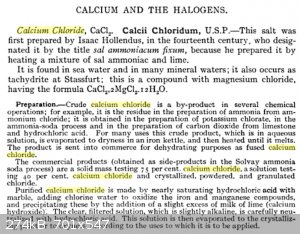 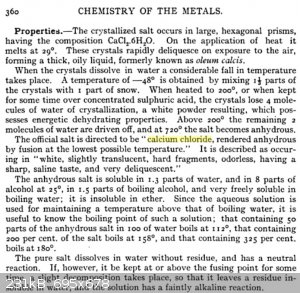
"A Text-book of Chemistry: Intended for the Use of Pharmaceutical and Medical Students
Samuel Philip Sadtler, Virgil Coblentz
J.B. Lippincott Company, 1908"
The idea is that after the initial dehydration stages at low temperature, the remaining moisture is driven off by fusion. In order to minimize
decomposition by the moisture in the air, this fusion temperature is maintained as low as possible, for as short a time as possible (a few minutes
from personal experience).
At the same time, it is possible to dehydrate CaCl2 at lower temperatures, 500-600°C, if this temperature is maintained for several hours.
The caveat with this method is that ammonium chloride should be added to it to minimize CaCl2 decomposition, and the air environment
around the salt needs to be moisture free.
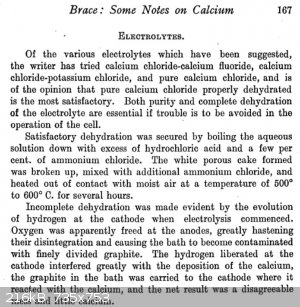
"Journal of the Institute of Metals, Volume 25
The Institute, 1921"
The previous examples involve making truly anhydrous CaCl2 without a significant amount of CaO contamination. For simple drying purposes,
boiling down the salt and heating it up to 300°C for a few hours is probably sufficient.
|
|
|
aga
Forum Drunkard
    
Posts: 7030
Registered: 25-3-2014
Member Is Offline
|
|
The proof is in the Pudding i guess.
Tonight i have a some freshly made Ca(NO3)2and some of the CaCl2 . verylitle H2O in trays in a sealed
plastic bag.
We'll see if the chloride really likes water enough to fight the nitrate for it.
Edit:
Many thanks for the scans/quotes WGTR.
[Edited on 20-9-2014 by aga]
[Edited on 20-9-2014 by aga]
|
|
|
blogfast25
International Hazard
    
Posts: 10562
Registered: 3-2-2008
Location: Neverland
Member Is Offline
Mood: No Mood
|
|
Quote: Originally posted by aga  | Tonight i have a some freshly made Ca(NO3)2and some of the CaCl2 . verylitle H2O in trays in a sealed
plastic bag.
|
That's quite an interesting experiment.
Will ΔG < 0 for Ca nitrate hydrate + CaCl2 anhydrous === > Ca nitrate anhydrous + CaCl2 hydrate?
My guess is that you won't be able to fully dehydrate the nitrate with the chloride...
aga, does this Ca nitrate hydrate look fairly dryish?
[Edited on 20-9-2014 by blogfast25]
|
|
|
Refinery
Hazard to Others
  
Posts: 371
Registered: 17-2-2014
Member Is Offline
Mood: Still
|
|
Can you not dry the calcium nitrate by heating? Being decently pure, it begins to decompose at 650C so any normal ovening does not hurt it a little
bit.
|
|
|
aga
Forum Drunkard
    
Posts: 7030
Registered: 25-3-2014
Member Is Offline
|
|
Nothing has changed at all.
The Chloride seems as dry as it it was at the start and the Nitrate is still a syrupy, and slightly yellow mixture, and has roughly the same viscosity
after ~24 hours.
Seems the Nitrate is more than happy to punch the Chloride's lights out over the water.
I did find some data saying it decomposes, but the 650 C wasn't specified, hence trying a dessicator.
Boil to dryness it is then ... where's that burger flipper ...
[Edited on 21-9-2014 by aga]
|
|
|
Refinery
Hazard to Others
  
Posts: 371
Registered: 17-2-2014
Member Is Offline
Mood: Still
|
|
Vacuum desiccate it? Sub-millibar vacuum with hot water bath should do the job. Calcium nitrate can take severe beating without destabilizing a little
bit, and when it does, it just releases NO2 fumes. This can be used to mass produce nitric acid.
I'd just put it into oven sheet and heat to max. It would be dry enough for my purposes.  You might wanna agitate the mass frequently and when it's dry, it will be caked so you need to drive it through blender and mesh it to get
fine powder, and this powder you can final dry by putting it into steel pot and putting it back to max. oven. It wont cake anymore because the
residual moisture would be so small, but then you can get very fine and very dry powder. I've dried some hygroscopic materials this way with excellent
results. You might wanna agitate the mass frequently and when it's dry, it will be caked so you need to drive it through blender and mesh it to get
fine powder, and this powder you can final dry by putting it into steel pot and putting it back to max. oven. It wont cake anymore because the
residual moisture would be so small, but then you can get very fine and very dry powder. I've dried some hygroscopic materials this way with excellent
results.
[Edited on 22-9-2014 by Refinery]
|
|
|